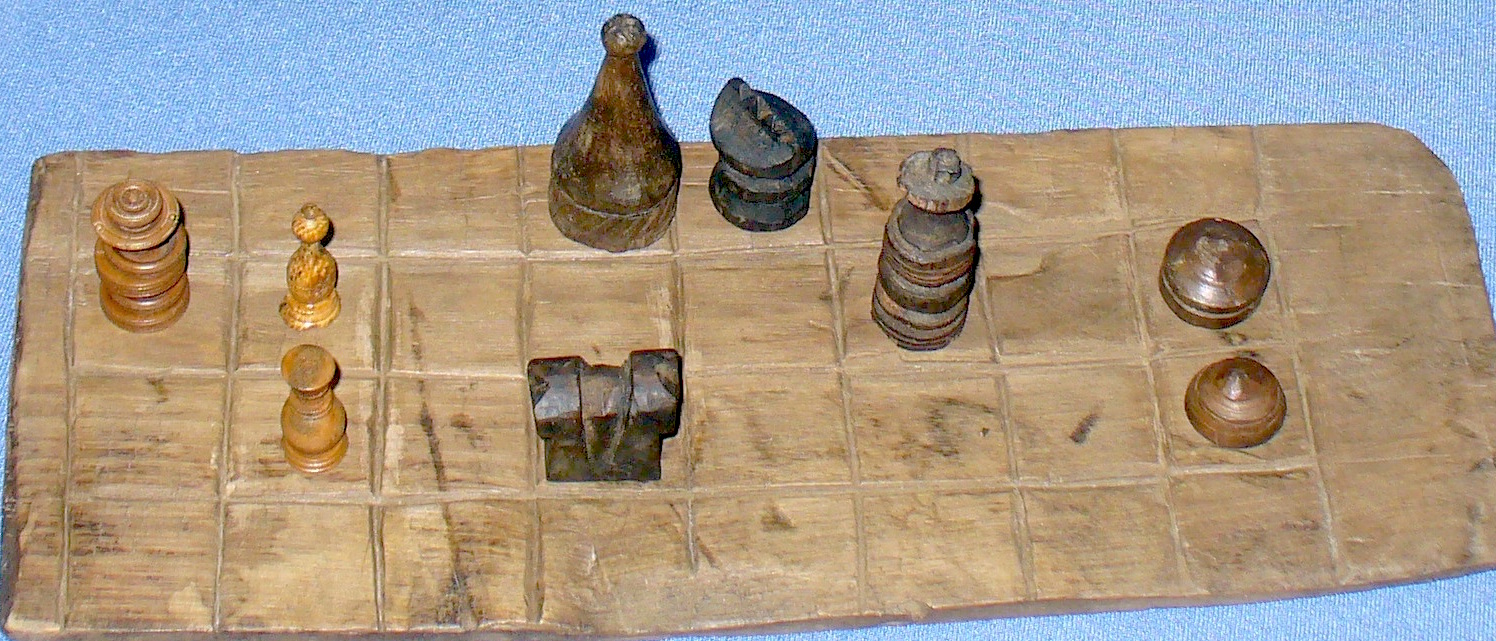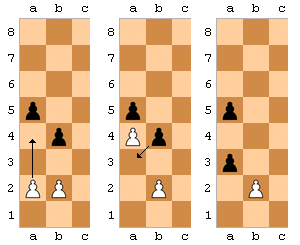|
Berolina Chess
Berolina chess is a chess variant using a popular fairy chess piece called the Berolina pawn (also known as ''Berlin pawn'', ''Anti-pawn'', or simply ''Berolina''). The Berolina pawn was invented by Edmund Nebermann in 1926''Funkschach'', August 1926 and has found frequent use in chess problems. Berolina chess follows the same rules as standard chess, except that all 16 pawns are replaced by equivalently-colored Berolina pawns. Berolina pawn The Berolina pawn moves, without capturing, one square diagonally forward. It captures one square straight forward. (Thus, it is the converse of a standard chess pawn, which moves straight forward and captures diagonally forward.) The Berolina has the option to move two squares diagonally forward on its first move. Capturing '' en passant'' is possible as well: a Berolina pawn may capture a horizontally adjacent enemy Berolina pawn that has just made a two-square move as if the latter had only moved one square. Like the orthodox pawn, ... [...More Info...] [...Related Items...] OR: [Wikipedia] [Google] [Baidu] |
Chess Variant
A chess variant is a game related to, derived from, or inspired by chess. Such variants can differ from chess in many different ways. "International" or "Western" chess itself is one of a family of games which have related origins and could be considered variants of each other. Chess developed from '' chaturanga'', from which other members of this family, such as ''shatranj'', Tamerlane chess, '' shogi'', and ''xiangqi'' also evolved. Many chess variants are designed to be played with the equipment of regular chess. Most variants have a similar public-domain status as their parent game, but some have been made into commercial proprietary games. Just as in traditional chess, chess variants can be played over the board, by correspondence, or by computer. Some internet chess servers facilitate the play of some variants in addition to orthodox chess. In the context of chess problems, chess variants are called heterodox chess or fairy chess. Fairy chess variants tend to be created ... [...More Info...] [...Related Items...] OR: [Wikipedia] [Google] [Baidu] |
Fairy Chess Piece
A fairy chess piece, variant chess piece, unorthodox chess piece, or heterodox chess piece is a chess piece not used in conventional chess but incorporated into certain chess variants and some chess problems. Compared to conventional pieces, fairy pieces vary mostly in the way they move, but they may also follow special rules for capturing, promotions, etc. Because of the distributed and uncoordinated nature of unorthodox chess development, the same piece can have different names, and different pieces can have the same name in various contexts. Most are symbolised as inverted or rotated icons of the standard pieces in diagrams, and the meanings of these "wildcards" must be defined in each context separately. Pieces invented for use in chess variants rather than problems sometimes instead have special icons designed for them, but with some exceptions (the princess, empress, and occasionally amazon), many of these are not used beyond the individual games for which they were invented ... [...More Info...] [...Related Items...] OR: [Wikipedia] [Google] [Baidu] |
Chess Problem
A chess problem, also called a chess composition, is a puzzle set by the composer using chess pieces on a chess board, which presents the solver with a particular task. For instance, a position may be given with the instruction that White is to move first, and checkmate Black in two moves against any possible defence. A chess problem fundamentally differs from over-the-board play in that the latter involves a struggle between black and white, whereas the former involves a competition between the composer and the solver. Most positions which occur in a chess problem are 'unrealistic' in the sense that they are very unlikely to occur in over-the-board play. There is a good deal of specialized jargon used in connection with chess problems; see glossary of chess problems for a list. Definition The term "chess problem" is not sharply defined: there is no clear demarcation between chess compositions on the one hand and puzzles or tactical exercises on the other. In practice, however, t ... [...More Info...] [...Related Items...] OR: [Wikipedia] [Google] [Baidu] |
Chess
Chess is a board game for two players, called White and Black, each controlling an army of chess pieces in their color, with the objective to checkmate the opponent's king. It is sometimes called international chess or Western chess to distinguish it from related games, such as xiangqi (Chinese chess) and shogi (Japanese chess). The recorded history of chess goes back at least to the emergence of a similar game, chaturanga, in seventh-century India. The rules of chess as we know them today emerged in Europe at the end of the 15th century, with standardization and universal acceptance by the end of the 19th century. Today, chess is one of the world's most popular games, played by millions of people worldwide. Chess is an abstract strategy game that involves no hidden information and no use of dice or cards. It is played on a chessboard with 64 squares arranged in an eight-by-eight grid. At the start, each player controls sixteen pieces: one king, one queen, two rooks, t ... [...More Info...] [...Related Items...] OR: [Wikipedia] [Google] [Baidu] |
En Passant
''En passant'' (, "in passing") is a method of capturing in chess that occurs when a pawn captures a horizontally adjacent enemy pawn that has just made an initial two-square advance. The capturing pawn moves to the square that the enemy pawn passed over, as if the enemy pawn had advanced only one square. The rule ensures that a pawn cannot use its two-square move to safely skip past an enemy pawn. Capturing ''en passant'' is permitted only on the turn immediately after the two-square advance; it cannot be done on a later turn. The capturing move is sometimes notated by appending the abbreviation e.p. Rules The conditions for a pawn to capture an enemy pawn ''en passant'' are as follows: * the enemy pawn advanced two squares on the previous move; * the capturing pawn attacks the square that the enemy pawn passed over. If these conditions are met, the capturing pawn can move diagonally forward to the square that the enemy pawn passed, capturing the enemy pawn as if it h ... [...More Info...] [...Related Items...] OR: [Wikipedia] [Google] [Baidu] |
Pawn (chess)
The pawn (♙, ♟) is the most numerous and weakest piece in the game of chess. It may move one vacant square directly forward, it may move two vacant squares directly forward on its first move, and it may capture one square diagonally forward. Each player begins a game with eight pawns, one on each square of their second . The white pawns start on a2 through h2; the black pawns start on a7 through h7. Individual pawns are referred to by the on which they stand. For example, one speaks of "White's f-pawn" or "Black's b-pawn". Alternatively, they can be referred to by the piece which stood on that file at the beginning of the game, e.g. "White's king bishop's pawn" or "Black's queen knight's pawn". It is also common to refer to a rook's pawn, meaning any pawn on the a- or h-files, a knight's pawn (on the b- or g-files), a bishop's pawn (on the c- or f-files), a queen's pawn (on the d-file), a king's pawn (on the e-file), and a central pawn (on the d- or e-files). The pawn histori ... [...More Info...] [...Related Items...] OR: [Wikipedia] [Google] [Baidu] |
Promotion (chess)
In chess, promotion is the replacement of a pawn with a new piece when the pawn is moved to its last . The player replaces the pawn immediately with a queen, rook, bishop, or knight of the same . The new piece does not have to be a previously captured piece. Promotion is mandatory; the pawn cannot remain as a pawn. Promotion to a queen is known as queening; promotion to any other piece is known as underpromotion. Promotion is almost always to a queen, as it is the most powerful piece. Underpromotion might be done for various reasons, such as to avoid stalemate or for tactical reasons related to the knight's unique movement pattern. Promotion or the threat of it often decides the result in an endgame. Rules When a pawn is promoted, it is removed from the board, and the new piece is placed on the square of promotion. A piece may be promoted to regardless of whether it has been captured. Consequently, a player might have two or more queens, or three or more rooks, bishops, or kni ... [...More Info...] [...Related Items...] OR: [Wikipedia] [Google] [Baidu] |
Hans Bodlaender
Hans Leo Bodlaender (born April 21, 1960) is a Dutch computer scientist, a professor of computer science at Utrecht University. Bodlaender is known for his work on graph algorithms and parameterized complexity and in particular for algorithms relating to tree decomposition of graphs. Life and work Born in Bennekom, Bodlaender was educated at Utrecht University, earning a doctorate in 1986 under the supervision of Jan van Leeuwen with the thesis ''Distributed Computing – Structure and Complexity.'' After postdoctoral research at the Massachusetts Institute of Technology in 1987, he returned to Utrecht as a faculty member. In 1987 he was appointed Assistant Professor and in 2003 Associate Professor. In 2014 he became full professor of algorithms and complexity at Utrecht, and at the same time added a part-time professorship in network algorithms at Eindhoven University of Technology. Bodlaender has written extensively about chess variants and founded the website ''The Chess Va ... [...More Info...] [...Related Items...] OR: [Wikipedia] [Google] [Baidu] |
The Chess Variant Pages
''The Chess Variant Pages'' is a non-commercial website devoted to chess variants. It was created by Hans Bodlaender in 1995. The site is "run by hobbyists for hobbyists" and is "the most wide-ranging and authoritative web site on chess variants". The site contains a large compilation of games with published rules. The aims of the site are to educate readers about chess variants, encourage gameplay, and provide a place for free discussion. The site has featured game competitions as well as variant design competitions, and provides facilities for publishing documents. Numerous files are available for playing variants using the Zillions of Games proprietary software engine. The site also features The Game Courier software developed by Fergus Duniho which can be used to play almost any variant. There is also an extensive encyclopedia of fairy chess piece A fairy chess piece, variant chess piece, unorthodox chess piece, or heterodox chess piece is a chess piece not used in conventio ... [...More Info...] [...Related Items...] OR: [Wikipedia] [Google] [Baidu] |
Java (programming Language)
Java is a high-level, class-based, object-oriented programming language that is designed to have as few implementation dependencies as possible. It is a general-purpose programming language intended to let programmers ''write once, run anywhere'' ( WORA), meaning that compiled Java code can run on all platforms that support Java without the need to recompile. Java applications are typically compiled to bytecode that can run on any Java virtual machine (JVM) regardless of the underlying computer architecture. The syntax of Java is similar to C and C++, but has fewer low-level facilities than either of them. The Java runtime provides dynamic capabilities (such as reflection and runtime code modification) that are typically not available in traditional compiled languages. , Java was one of the most popular programming languages in use according to GitHub, particularly for client–server web applications, with a reported 9 million developers. Java was originally developed ... [...More Info...] [...Related Items...] OR: [Wikipedia] [Google] [Baidu] |


.png)


